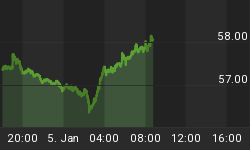Patience is the key word for gold and gold shares this month. Corrections were needed in the markets to consolidate the excesses and that's what we've been seeing. But it's easy to get impatient with a market that produced great gains last year, especially when the base metals like copper continue to soar and platinum is testing its 1980 highs. Even silver has been reaching new highs.
Copper and the other base metals, however, are in a league of their own, thanks to China. China and India are in a rush to build their infrastructure to sustain economic growth and they've been soaking up the commodities of the world. China's GDP grew 9.1% in 2003, which was the fastest in six years and it's now the second largest oil importer after the U.S., which is why oil is flirting with its 1990 highs. Not only are oil imports up 30%, but China also consumed half of the world's cement, 30% of its coal and 36% of its steel.
COPPER: A blow off rise?
Copper also tends to rise during global economic recoveries and this too has added even more upward pressure to copper, which helped cause this month's surge as supplies were being depleted.
 If China continues to grow at a similar pace this year, we could see even higher prices, but copper could also be in a "blow off" rise (see Chart 1A). Note that it's breaking above its major downtrend, it reached its 1995 highs while the leading indicator has now risen to its major high area (see Chart 1B). As you can see, each time a high area was reached, it has coincided with a top area in copper. Plus, it's happening while the dollar is rising in a rebound rise, which will also put pressure on copper. But even if copper declines to $1.15, it would still be strong.
If China continues to grow at a similar pace this year, we could see even higher prices, but copper could also be in a "blow off" rise (see Chart 1A). Note that it's breaking above its major downtrend, it reached its 1995 highs while the leading indicator has now risen to its major high area (see Chart 1B). As you can see, each time a high area was reached, it has coincided with a top area in copper. Plus, it's happening while the dollar is rising in a rebound rise, which will also put pressure on copper. But even if copper declines to $1.15, it would still be strong.
Many believe China's economy is overheating and if it is, we'll surely see a weaker copper price as the economy cools down. But China is the new kid on the international block and no one quite knows how to treat them. Will they stay robust? Are they overheating? One thing we do know, they are here to stay for the long-term and the world will continue to be affected by this.
So whether or not China slows its rapid growth near-term, it'll keep growing, producing and modernizing for years to come. Many are already saying China will be the power of the 21st century, just as the U.S. was in the 20th century and the U.K. in the 19th century. That alone is going to influence the markets, as we're already seeing.
This imbalance in the world will eventually strain all major currencies because the country with the weakest currency will have the edge to export at a better price. This is where gold fits in. It will be the currency of last resort.
GOLD: Bull market underway
Meanwhile, gold has been declining since January 9th in a decline we call D. This is normal when looking at both the big picture and the intermediate one. We've been taking this bull market one step at a time and so far the steps are still in place.

Looking at the big picture first, Chart 2 shows that gold moves in a 1-4 movement. The #1 rises are the best bull markets in gold. The rise to the 1980 high, for example, was a #1 rise, just like the rises in 1985-87 and 1993-96 were. The declines preceding these bull market rises (#4) tend to fall to new lows within each 1-4 movement.
But the 2001 low (the last #4) was different because gold did not fall to new lows. This was the first sign of a major change. Gold then rose above its 65-week moving average in August, 2001 where it has stayed since then. This rising moving average provides solid support at $370. Then in December, 2002 gold moved up into the second step of the bull market when it broke above its prior #3 peak. This was a milestone because gold hadn't been able to do this since the surging rise of the 1970s. The 1996 high then became the next target and gold completed this target last January.
Now gold could fluctuate within this step between $330 and $427 in the coming months, and technically, the big picture bull would still be on track.
But if gold stays above $370 and eventually breaks above $427, gold will be entering the third step where $427 would become the solid support and the next target would then be the 1987 high near $500.
Many people argue that 2004 is a likely time for the bull market to end. It ties in with the 11 year peaks that follow the 8 year cycle lows and gold's rise has already been similar in time and movement to the 1980s and 1990s rises. We agree 2004 is a key year for the bull market. If gold breaks into the third step this year, gold would then be more in line with the 1970s rise. But if gold moves within the second step level this year, we could see a postponed bull market.















